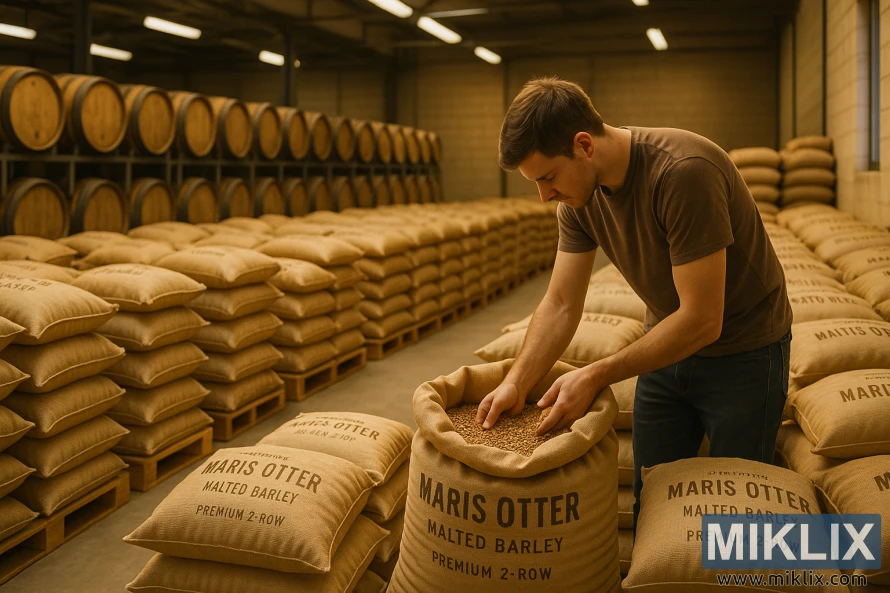Image: Maris Otter malt storage facility
Published: August 11, 2025 at 5:17:51 AM UTC
Last updated: September 27, 2025 at 3:57:08 PM UTC
A spacious malt facility with casks and sacks of Maris Otter malt under golden light, where a worker inspects grains to ensure quality and freshness.
Bathed in a warm, amber-toned glow that evokes both comfort and industrious purpose, the malt storage facility depicted in the image is a harmonious blend of tradition, precision, and reverence for the brewing craft. The space is expansive and orderly, its high ceilings and clean layout suggesting a well-maintained environment where every element is curated for optimal preservation and accessibility. The lighting, likely natural or softly diffused through industrial fixtures, casts golden highlights across the burlap sacks and wooden barrels, enhancing the tactile richness of the materials and the earthy tones of the malted grains within.
In the foreground, a worker stands engaged in a moment of quiet inspection, his posture attentive and deliberate. He leans over a large open sack labeled “MARIS OTTER MALTED BARLEY PREMIUM 2-ROW,” gently sifting through the grains with practiced hands. The malted barley glows under the light, its golden-brown kernels plump and uniform, exuding a subtle sheen that speaks to their freshness and quality. This is not a casual glance—it’s a ritual of stewardship, a gesture that reflects the brewer’s intimate relationship with his ingredients. The worker’s presence adds a human dimension to the scene, reminding the viewer that behind every great beer lies the care and expertise of those who tend to its raw materials.
Stretching into the middle ground, rows of identical burlap sacks are stacked with geometric precision, their labels facing outward in a quiet display of pride and consistency. Each sack bears the same designation, reinforcing the singular focus of the facility: the storage and handling of Maris Otter malt, a variety celebrated for its rich, biscuity flavor and reliable performance in brewing. The sacks are arranged in a way that suggests both efficiency and reverence, as if each one holds not just grain, but potential—flavor waiting to be unlocked, stories waiting to be brewed.
Beyond the sacks, the background reveals a line of wooden barrels, their curved staves and iron hoops forming a rhythmic pattern against the brick wall. These barrels, likely used for aging or conditioning, add depth and character to the space. Their presence hints at the broader lifecycle of the malt, from storage to fermentation to maturation. The barrels are aged but sturdy, their surfaces darkened by time and use, and they contribute to the overall atmosphere of craftsmanship and continuity.
The facility itself is a study in balance—between utility and beauty, between tradition and modernity. The clean floors, organized layout, and thoughtful lighting suggest a space designed not just for function, but for inspiration. It’s a place where ingredients are honored, where processes are respected, and where every detail matters. The air, though invisible, seems thick with the aroma of malted barley—nutty, sweet, and faintly toasted—a scent that evokes both the field and the brewhouse.
This image captures more than a storage room—it encapsulates a philosophy of brewing that begins with care and ends in character. It invites the viewer to appreciate the quiet labor that precedes the boil, the unseen decisions that shape the final pint. Maris Otter malt, central to the composition and the craft, is treated not as a commodity but as a cornerstone. And in this golden-lit sanctuary of grain and wood, the spirit of brewing lives on, one sack, one barrel, and one careful inspection at a time.
The image is related to: Brewing Beer with Maris Otter Malt

